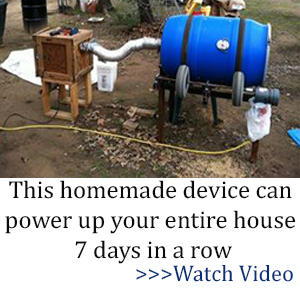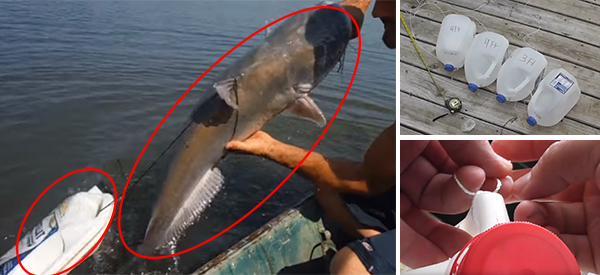Jug line fishing is an easy method that has been around for a long time. First timers and seasonal fishermen find this method to be consistent, effective, and low cost. If you are in an area with a decent amount of fish, the jug line method is a sure bet for plenty of action.
So, if you enjoy fishing and have never heard of jug line fishing, or don’t know how to go about it, this article and video will provide some helpful information.
What Is Jug Fishing?
Jug fishing is often referred to as “jugging” because it utilizes jugs to float in the water for catching fish, with bait suspended beneath each jug. The way this is set up, allows covering of a large area in the water, without having to constantly tend to a line and rod.
Supplies for Jug Fishing
 First, you will want to collect some jugs. Plastic jugs work well because they are light, durable, and inexpensive. Examples of jugs many fishermen use include the following:
First, you will want to collect some jugs. Plastic jugs work well because they are light, durable, and inexpensive. Examples of jugs many fishermen use include the following:
- 2-liter soda bottles
- Milk jugs (quart or gallon)
- Bleach bottles
Basically, any plastic container that is sturdy and has a strong seal, should work.
You will also need fishing line and bait. For the line, typically a 50 – 65 Lb test braid or Dacron works great. The bait could be anything that you would normally use for the specific fish you are attempting to catch; but we’ll talk about this later.
Another thing to consider is adding weight, especially if you plan on leaving the jugs unattended. Securing a weight to the jug will help keep the jug in place.
Related: 15 Survival Uses for Plastic Bottles
Jug Fishing Technique
 Setting up various jugs with varying line lengths will allow you to spread the jugs throughout different water depths.
Setting up various jugs with varying line lengths will allow you to spread the jugs throughout different water depths.
Also, if you have different types of bait, you will lure more than one type of fish.
Varying the lengths and bait will also show you what is working, and what is not. While the jugs that are working continue to work, you can start adjusting the jugs that are sitting idle for too long.
The jugs will start to bob, like a bobber, when fish have taken the bait. When you notice this, you can get to the jug to pull in the fish you find on the line
Just keep in mind that jug fishing is best done in waters with mild to no current, and decent weather conditions. Too much movement in the water, your jugs and lines will get entangled in possible debris and become quite difficult to maneuver, or will get lost completely.
Related: The Three-Year Shelf Life Viking Survival Food (With Pictures)
Use the following steps as a guide to get started:
- Decide the length of your line. If you know the water’s depth, that will help determine the line length you should work with, while the bait suspends near the water’s floor.
- Fasten the line to the jug.
- Attach some weight towards the end of the line, about 2 pounds or more if you want them to be less mobile, such as a brick. Use less than 1 pound for free-floating jugs. And, if the conditions are windy, add more.
- Attach a hook to the end of the line, hook size depending on the type of fish you want to catch. Some people attach 2 hooks, 1 above the weight, and the other at the end of the line. This allows the jug to float into more shallow water and still be effective.
- Attach the other end of the line around the jug’s “neck”.
You now have a properly rigged jug for jug fishing. Just repeat the process with as many jugs you want to have in the water.
Jug Fishing Tips
Here are a few tips to remember:
- Once the work is done in prepping, the actual fishing process is quite passive. This gives you flexibility in when you can set it up, such as in the evening, and then checking the next morning to see what has been caught. Catfish, for example, are known to stay active at night. So you could be catching tomorrow’s dinner while you sleep. They are quite capable of swimming away with your jug though, if there is not enough weight on it.
- Pay attention to water temperatures. If it’s mid-summer in a hot climate with warmer water temps, the fish could die quickly. So, check on the jugs every hour or so in hot weather.
- Brightly colored jugs are easier to spot on the surface, which is important when they drift.
Best Bait for Jug Fishing
This will depend on what you are trying to catch. If you are hoping for catfish, a variety of baits are effective. But, since they have a great sense of smell, stinky baits are often used.
Other bait options include: herring, shad, perch, drum, night crawlers, crickets, grasshoppers, turkey or chicken liver, shrimp.
However, trying a variety of bait will show you what works for your particular area and conditions.
Related: All-Natural Fruit Tree Bait for Insects: It Works!
Jug Fishing Regulations
Jug line fishing isn’t allowed in all jurisdictions. Make sure you check what your local regulations are before you drop the first jug.
Where it is allowed, you might have to label each jug with your name, address, and your fishing permit number.
In some areas, it is required that you remain present at all times.
Also, each state and area will have their own set of regulations, governing things such as:
- The number of jugs allowed to be in use at one time
- Number of hooks required/allowed per jug
- Size of the fish caught
- Number of fish caught
To sum it up, jug fishing is a simple, yet effective method in catching fish. It’s a great way to get kids and people who have never fished introduced to fishing.
You may also like:
 Winter Sowing Technique That Guarantees The Best Crops
Winter Sowing Technique That Guarantees The Best Crops
The U.S. Army’s Forgotten Food Miracle (Video)
25 Survival Uses For Leftover Bacon Grease















Outstanding Article, and a ton of fun. Easy to do and lots of fun for all ages. Thanks Claude!! Merry Christmas to You and Your Family. It’s always a PLEASURE to read your posts.
Jug fishing around here was unregulated until it exploded in popularity in the 1970s and became a danger to boaters, skiers, divers and other fisherman. Another way to rig a jug is to set a heavy anchor and shorten the line so that the jug is hidden 1-2 feet under the surface, you just have to remember where your jugs are and check them regularly.
Another cool obnoxious productive way of fishing is the rubber band line. They used to sell long stout rubber bands you could anchor out in the water, stretch it to shore and attach a long line with multiple hooks then let the rubber band pull it out into the water, then check it ever so often just by pulling it in. Pretty cool but I think they have drowned more than 1 swimmer.
When my Dad was a little country boy in the Depression times his fishing gear was 20′ of string, tie a bent nail on the end, add some grub worms, crickets, or a grass hopper.
That’s pretty crazy! Most likely not legal here in California… like everything else.
Don’t worry.. Admit to the illegal activity, then claim sanctuary. Punishing illegal acts in California appear to be an illegal act in itself.
I don’t fish, find it boring. But That’s Me! article raised my eyebrow in WOW maybe i’ll give it a go with my little girl. I’ve become a pushover since having my daughter LOL. Enjoyed the article and gave Thumbs Up to all comments. Ain’t that the truth about California SMH. i Like, OLE!
jug fishing, trout lines and auto fishers will be critical in a serious SHTF >> time & labor multiplying like this will be necessary along with the possible need to fish covertly as possible ….
Great article!
Now, how do we guys catch “Jugs” with a fish???
Sorry, I couldn’t help myself…………………………..lol!